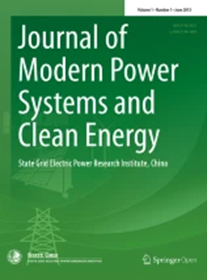Security Risk Assessment and Risk-oriented Defense Resource Allocation for Cyber-physical Distribution Networks Against Coordinated Cyber Attacks
IF 5.7
1区 工程技术
Q1 ENGINEERING, ELECTRICAL & ELECTRONIC
Journal of Modern Power Systems and Clean Energy
Pub Date : 2024-07-05
DOI:10.35833/MPCE.2024.000288
引用次数: 0
Abstract
With the proliferation of advanced communication technologies and the deepening interdependence between cyber and physical components, power distribution networks are subject to miscellaneous security risks induced by malicious attackers. To address the issue, this paper proposes a security risk assessment method and a risk-oriented defense resource allocation strategy for cyber-physical distribution networks (CPDNs) against coordinated cyber attacks. First, an attack graph-based CPDN architecture is constructed, and representative cyber-attack paths are drawn considering the CPDN topology and the risk propagation process. The probability of a successful coordinated cyber attack and incurred security risks are quantitatively assessed based on the absorbing Markov chain model and National Institute of Standards and Technology (NIST) standard. Next, a risk-oriented defense resource allocation strategy is proposed for CPDNs in different attack scenarios. The trade-off between security risk and limited resource budget is formulated as a multi-objective optimization (MOO) problem, which is solved by an efficient optimal Pareto solution generation approach. By employing a generational distance metric, the optimal solution is prioritized from the optimal Pareto set of the MOO and leveraged for subsequent atomic allocation of defense resources. Several case studies on a modified IEEE 123- node test feeder substantiate the efficacy of the proposed security risk assessment method and risk-oriented defense resource allocation strategy.求助全文
约1分钟内获得全文
求助全文
来源期刊

Journal of Modern Power Systems and Clean Energy
ENGINEERING, ELECTRICAL & ELECTRONIC-
CiteScore
12.30
自引率
14.30%
发文量
97
审稿时长
13 weeks
期刊介绍:
Journal of Modern Power Systems and Clean Energy (MPCE), commencing from June, 2013, is a newly established, peer-reviewed and quarterly published journal in English. It is the first international power engineering journal originated in mainland China. MPCE publishes original papers, short letters and review articles in the field of modern power systems with focus on smart grid technology and renewable energy integration, etc.
 求助内容:
求助内容: 应助结果提醒方式:
应助结果提醒方式:


